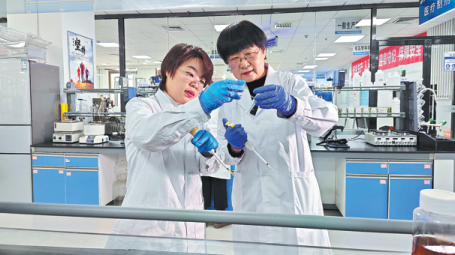Plan highlights moves to attract tech talents
Updated: 2023-12-08

Qu Zhican (right) and her colleague conduct an experiment at the lab of Shanxi Nanolattix Biotechnology. [Photo by Deng Yingmin for China Daily]
North China's Shanxi province will implement an action plan to substantially increase its number of scientific and technological researchers and management personnel.
The initiative aims to mitigate the shortage of related human resources, and optimize the structure of the local talent pool, local officials said.
According to the plan, by the end of the 14th Five-Year Plan (2021-25), the number of research and development personnel per 10,000 employees will witness a rapid rise, with an average annual growth rate of more than 20 percent.
In addition to nurturing local talents, Shanxi has also been making efforts for years to attract talented individuals from overseas. Qu Zhican, who graduated from Johns Hopkins University with a PhD degree, is one of them.
In 2018, Qu returned to her hometown with startup capital and biological technologies with independent intellectual property rights, and founded Shanxi Nanolattix Biotechnology. The company is committed to the innovative development of anti-cancer medicines, and scientific research and technological achievement transfer in the big health industry.
At the eighth "Makers in China" SME Innovation and Entrepreneurship Competition, Shanxi has 10 projects included in a list of top 500 projects nationwide, which was announced on Nov 16, and Nanolattix's biomedicine project made the list as the only one of its kind in the province.
Located at the Shanxi Transformation and Comprehensive Reform Demonstration Zone, Qu said the company has gained strong support from the zone in terms of policy, funding and human resources.
Also, the zone's international cooperation and investment promotion center, together with other government agencies, has helped the company explore markets and deal with various difficulties during the COVID-19 pandemic, which has effectively boosted its sustainable development, she added.
When it comes to cultivating high-quality scientists, researchers and technologists, Shanxi will focus on strategic emerging industries and "future industries" such as artificial intelligence and quantum computing, by setting up special funds dedicated to fostering innovation and entrepreneurial talents in these fields.
To increase the number of high-tech companies, especially small and medium-sized enterprises, is another highlight. By 2050, Shanxi is expected to be home to 10,000 State-level sci-tech SMEs and 5,000 national-level high-tech companies. It also plans to promote 100 high-tech enterprises to become globally renowned and nationally influential high-tech leaders.
Moreover, local R&D personnel will be encouraged to participate in global academic exchanges and cooperation, and be supported to undertake State-level international cooperation projects.
Shen Jia contributed to this story.
haonan@chinadaily.com.cn



